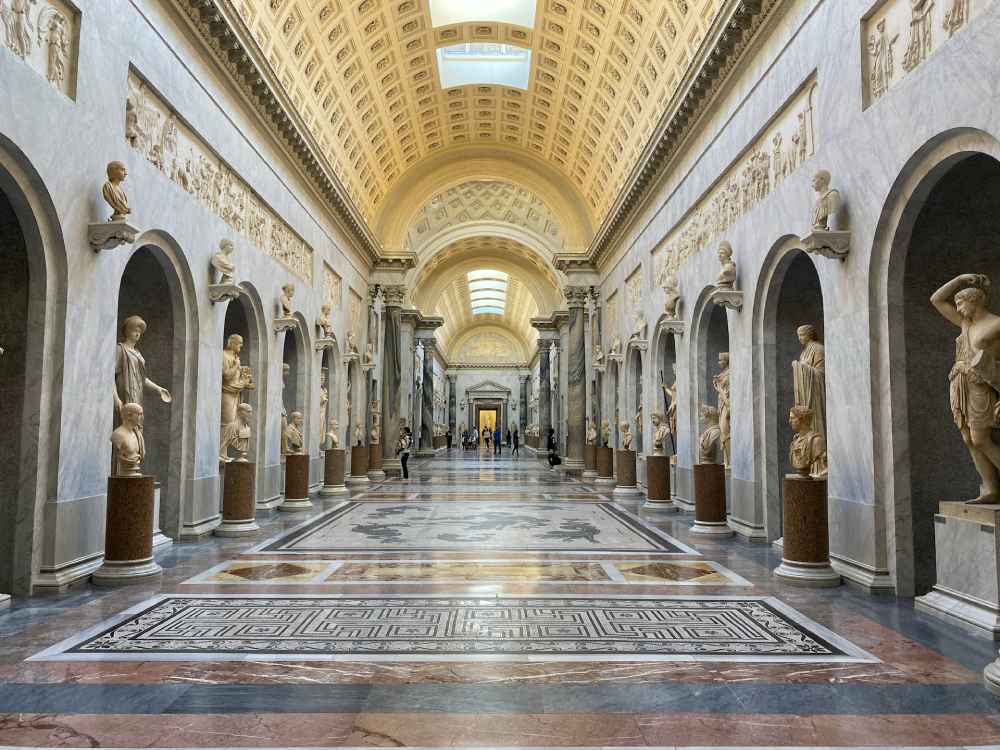Explore the rich art and history of the Vatican Museums through guided tours. Uncover timeless masterpieces, from intricate sculptures to breathtaking frescoes, while delving into the Vatican’s rich cultural heritage. With expert guides leading the way, immerse yourself in a captivating journey through centuries of artistic excellence and historical significance.
Introduction: A Journey Beyond Compare
An adventurer stepping into the realm of the Vatican Tours embarks on a voyage that transcends mere sightseeing. The Vatican Museums beckon with their hallowed halls, where time-honored masterpieces and architectural marvels narrate the saga of human achievement and divine inspiration.
Each artwork, from Michelangelo’s seminal frescoes to Raphael’s inspired murals, embodies an entire epoch, enabling visitors to traverse the vibrant tapestry of our civilization’s shared story.
Beyond being a paragon of artistic splendor, the Vatican Museums are pivotal in preserving the cultural patrimony that has profoundly shaped the world’s philosophical and spiritual outlook.
As connoisseurs of the arts and history embark on this immersive quest, they encounter the delicate interplay of light, color, and form that has captured the imagination of onlookers for centuries, breathing life into the chronicles of celebrated artisans and their venerable patrons.
The Legacy of the Sistine Chapel
Regarded as one of the pinnacles of Renaissance art, the Sistine Chapel’s awe-inspiring ceiling recounts tales from Genesis with a vivacity that seems to defy the confines of time. Michelangelo’s masterful depictions impart movement and emotion to biblical figures, evoking a sense of the divine amongst mortals.
The ‘Last Judgment,’ a later addition by the same maestro, serves as a monumental canvas that enfolds viewers in its apocalyptic grandeur and continues to astonish and inspire scholars, artisans, and patrons alike.
The Wonders of Papal Patronage
The artistic wonders enshrined within the Vatican Museums owe much to the patronage of the various pontiffs who have imprinted their legacy on the Church and Church world of art and architecture.
From the erudite Pope Julius II commissioning the Sistine Chapel’s frescoes to Pope Sixtus IV founding the Vatican Library, each successor of Saint Peter has contributed to a vast assemblage of artworks that meld religious devotion with aesthetic brilliance.
The pontiffs’ efforts in elevating the artistic heritage have led to a repository that captures the spirit of an age preoccupied with its capacities for creation and commemoration.
The Raphael Rooms: Harmony and Philosophy
Envisaged as Raphael’s tribute to theology and philosophy, the Stanze di Raffaello—often known as the Raphael Rooms—offers a panoramic view of the intellectual vigor that characterized the Renaissance.
These murals, brimming with symbolic significance, lead onlookers into eloquently rendered philosophical debates and invite them to contemplate human knowledge and divine wisdom. Arguably the most illustrious of these, ‘The School of Athens’ is a symbolic tableau reuniting antiquity’s luminaries in a timeless symposium.
A Map to a Bygone Era: The Gallery of Maps
The Gallery of Maps is a cartographic wonder, where frescoed depictions of Italy’s regions painted by Domenico Ghirlandaio serve as a reminder of the epoch when geographers were explorers and artists alike.
These maps reflect the Renaissance’s thrust toward discovery and knowledge, combining scientific precision with aesthetic enchantment, and stand as illuminating documents of the Church’s drive to catalog the world’s wonders.
Unveiling Hidden Stories in Tapestries
Unlike the Vatican Museums ‘ tapestries, only some artistic media can capture the luxury and intricacy of storytelling. These woven canvases depict biblical tales and historical events with vibrancy and detail that provoke a profound immersion.
With their textural richness and dynamic imagery, tapestries affect a tactile and contemplative engagement that bridges temporal divides and rekindles the narratives they ornament.
The Significance of Statuary in the Vatican
In the corridors of the Vatican, marble and bronze statues echo the silent dialogues of history, capturing in their solid forms the ideologies and aesthetics of ancient Rome, the Renaissance, and beyond.
These sculptural emissaries speak volumes about the evolving artistic tastes and theological doctrines that they embody. In their frozen poise, they are relics that narrate a tale of continuity – the story of humanity’s unwavering pursuit of depicting its identity and deities.
Contemporary Art and the Church: An Evolving Canvas
Despite its historical ambiance, the Vatican Museums engender a progressive narrative by incorporating contemporary works amid the lauded antiquities. By embracing art from the modern epoch, the Church signals its Churchgnition of the ongoing Renaissance that unfolds within human creative expression.
Including contemporary artists reflects a broader conversation between the Church and a rapidly changing cultural landscape, manifesting a sustained relevance and openness to dialogue.
The Eclectic Collection of the Vatican Museums
The Vatican Museums’ repertoire extends beyond Christian religious art to encompass an array of global treasures. The span of its collection, which includes Etruscan pottery, Egyptian sarcophagi, and even the Matisse room, symbolizes the Catholic Church’s ecumenical approach to art curation.
This museum contextualizes artworks as standalone masterpieces and dialog partners in an ongoing exchange between different cultures and eras. The thoughtful assemblage allows the Vatican Museums to stand as educational and inspirational repositories—an experience well captured in an expansive feature that highlights this vast intercultural journey through art.
Art Restoration and Conservation: Protecting the Past
The mission of the Vatican Museums extends into the formidable undertaking of art restoration and conservation. Stewards of history, curators, and conservators embrace the responsibility of extending the lifespan of artifacts, ensuring that they continue to inspire and educate future generations.
This dedication to preservation employs a blend of time-honored techniques and cutting-edge technology, balancing the duty to maintain the creator’s original vision with the imperative to withstand the test of time.
The Role of the Vatican Museums in Cultural Education
The Vatican Museums are not just cultural custodians; they are educators committed to demystifying the complexities of history and art for visitors from all walks of life. Through diverse programs and initiatives, the museums offer enriching experiences that transcend mere observation, fostering profound connections to the artwork and the narratives they encapsulate.
This educational aim is poignantly documented in an article. It elucidates the Vatican Museums’ approach to enhancing the visitor experience and promoting a deeper engagement with the cultural treasures housed within their walls.





